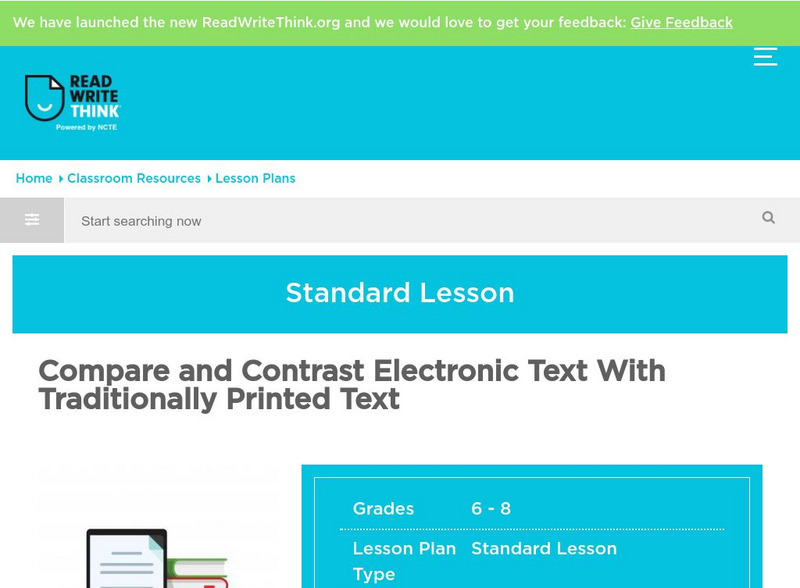Internet Infidels
The Ethics of Belief
This site contains an essay by W.K. Clifford which says that no one should maintain a belief that is not justified by evidence. This essay has been frequently cited in the 20th century as a classic work in the philosophy of religious...
Sophia Learning
Sophia: In Text Citations: Lesson 6
This lesson introduces in-text citations and how to embed them in text. It is 6 of 7 in the series titled "In-Text Citations." W.9-10.8 Sources
Sophia Learning
Sophia: How to Choose Credible Sources
This tutorial focuses on choosing credible sources for a research project. It offers two versions of a slideshow: a non-audio slideshow and an audio slideshow which explains the information as it is shown. They each define terms, offer...
Other
Ivcc: Integrating and Using Quotations Properly
Written for a college composition course, the ideas in this article are valid for journalists as well. The article gives examples of each of the 4 ways to use quotations in writing. W.9-10.2b Strong Support, L.9-10.2b Colons
Polk Brothers Foundation Center for Urban Education at DePaul University
Depaul University: Center for Urban Education: Map a Story or a History [Pdf]
This graphic organizer provides a story map. Students can use this visual resource to help them record major plot events from a story or from a historical event.
Polk Brothers Foundation Center for Urban Education at DePaul University
De Paul University: Center for Urban Education: I Can Identify and Infer Character Traits[pdf]
Students will identify character traits directly and inferentially with the help of this graphic organizer. Students will summarize their findings after completing the graphic organizer.
Polk Brothers Foundation Center for Urban Education at DePaul University
De Paul University: Center for Urban Education: I Can Identify and Infer Character Traits[pdf]
A poster offers guiding questions to help students with identifying character traits. Guiding questions are also provided to help them support their inferences about the character traits.
Polk Brothers Foundation Center for Urban Education at DePaul University
Depaul University: Center for Urban Education: I Can Explain an Inference [Pdf]
This tool can be used to help students articulate their answers about fiction pieces. Students will quote the text, provide an inference, and give a justification.
Polk Brothers Foundation Center for Urban Education at DePaul University
De Paul University: Center for Urban Education: Model How to Map Story or History Spanish[pdf]
Designed for students who speak Spanish, this graphic organizer provides a story map. Students can use this visual resource to help them record major plot events from a story or from a historical event.
Library and Archives Canada
Nlc: Defining Primary and Secondary Sources
Libraries and archives hold documents and books that can be used for your research projects. Learn how to divide and identify them into primary and secondary sources in this tutorial.
TES Global
Tes: Character Analysis
[Free Registration/Login Required] A downloadable graphic organizer for analyzing a character is provided on this page.
Harvard University
Harvard College Writing Center: How to Do a Close Reading
A brief explanation of the tasks involved in doing a close reading in preparation for writing. This writer breaks the process into three steps which involve annotating the text, looking for patterns, and asking questions of the text.
ReadWriteThink
Read Write Think: Text Features: Non Fiction [Pdf]
Compare the printed page to an electronic web page and use this activity to discuss the similarities and differences. A cross-curricular tie-in with ecosystems. Could easily be adapted to another subject area.
ReadWriteThink
Read Write Think: Compare/contrast Electronic Text With Traditionally Printed Text
Lesson allows for middle school students who are familiar with researching electronic sources to gain a deeper understanding of the benefits of online resources versus traditional print.
E Reading Worksheets
E Reading Worksheets: Inferences Worksheets
In this learning module, students will learn more about making inferences. Worksheets are provided to reinforce the skill of making inferences. This module is designed to support Tier I, Tier II, and Tier III students.
Other
Library of Congress: Teaching With Primary Sources
This website is an excellent resource for teaching with primary sources. This resource features Holocaust lessons, lesson plan strategies, and podcasts.
Khan Academy
Khan Academy: The Sat Reading Test: Information and Ideas
The Information and Ideas category of the SAT Reading Test includes questions that focus on what the passage says (directly or indirectly). To interpret the author's message, you'll need to consider both what's stated and what's implied...
ClassFlow
Class Flow: Finding the Main Idea & Inferences
[Free Registration/Login Required] This flipchart will help student find the main idea in writing as well as make inferences while reading. There are 2 web quests embedded that has numerous exercises with sound. There is an Activote...
SMART Technologies
Smart: Making Inferences
Inferencing is finding clues and using background knowledge to determine an explanation from facts in a passage or story. It's "reading between the lines" of a story to understand what the author doesn't state.
Polk Brothers Foundation Center for Urban Education at DePaul University
Depaul University: Center for Urban Education: I Can Make an Inference [Pdf]
Students can use this graphic organizer to help them make inferences about the information in a text and then explain the rationale for each.
BBC
Bbc Bitesize Revision: Some Purposes of Reading
As part of a review and close reading section of BBC Bitesize, this site presents an overview of various purposes of reading, including a five-bullet point explanation of reading purposes. Click the Next button for more information.




![Depaul University: Center for Urban Education: Map a Story or a History [Pdf] Graphic Depaul University: Center for Urban Education: Map a Story or a History [Pdf] Graphic](https://static.lp.lexp.cloud/images/attachment_defaults/resource/large/FPO-knovation.png)








